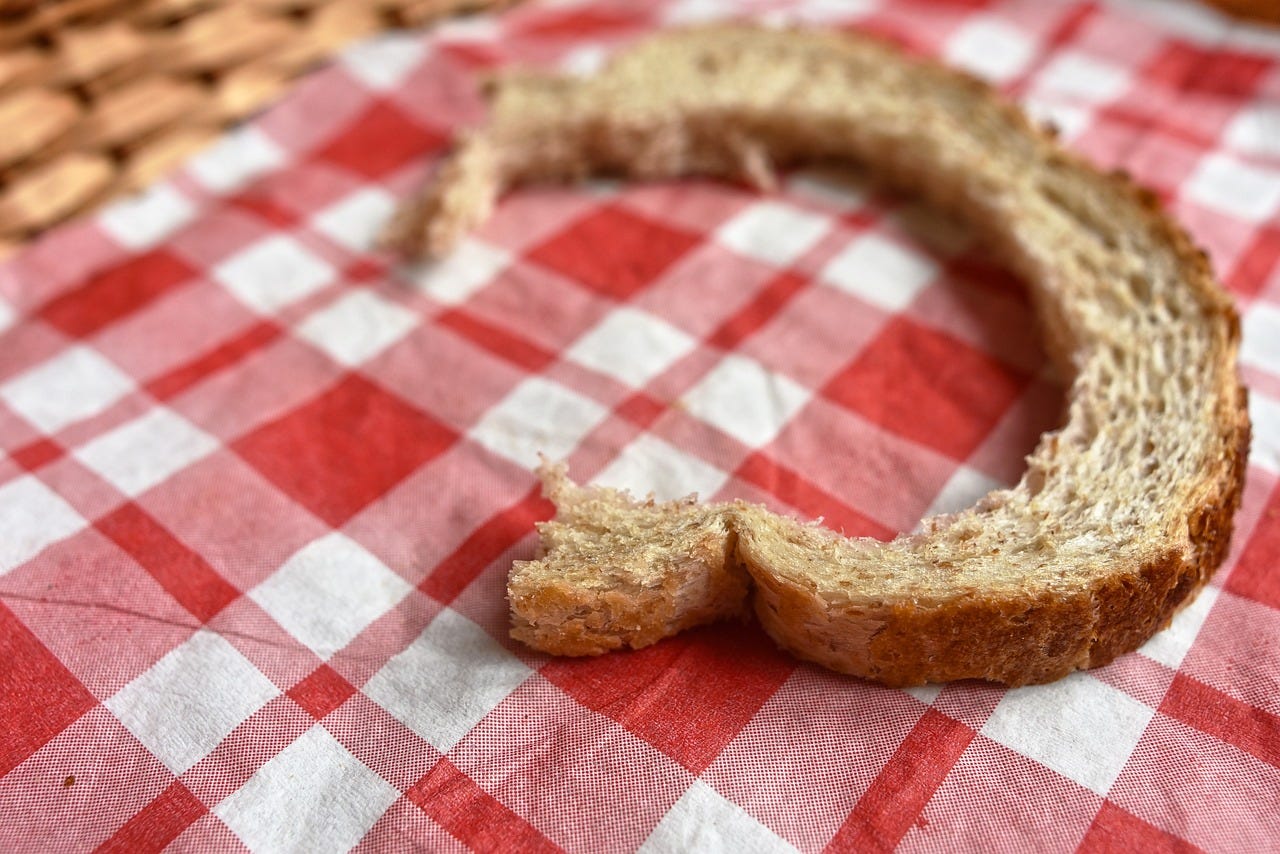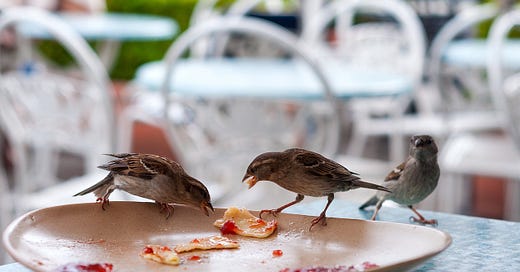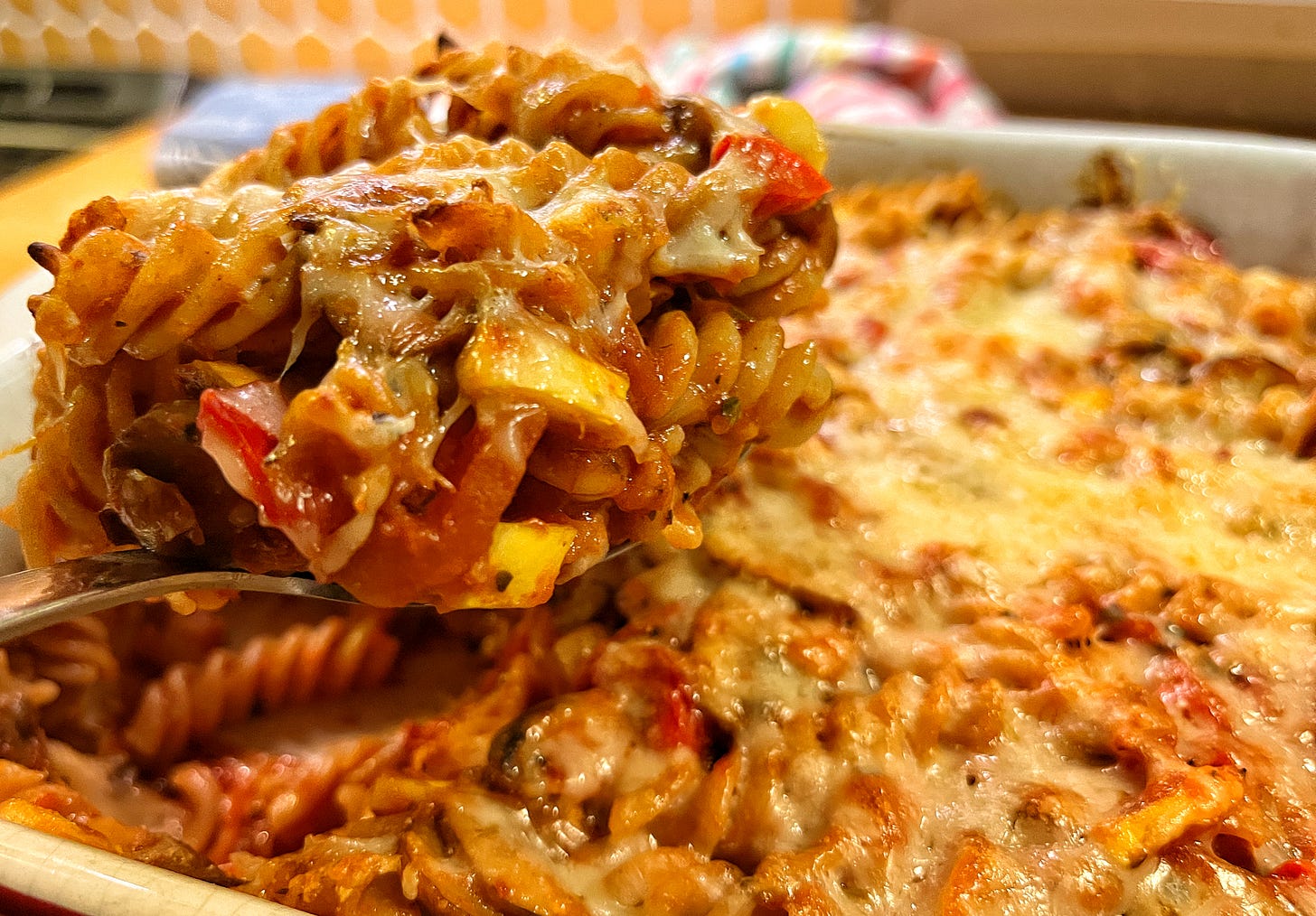Tackle food waste: No more slimy spinach from the back of the fridge
It’s leftover season! Let’s get creative with food, save money – and learn why food waste harms everyone.
Dear Climate Culinarians,
When I look at the length of a diner menu or at endless supermarket shelves full of different cereal boxes or those pretty grocery displays with vegetables in every color of the rainbow, I doubt anyone would understand how I grew up.

Like many small children, I was a picky eater. But I didn’t get to pick that much: My grandmother had little sympathy. I was supposed to eat whatever she served. And letting food go to waste was unthinkable for her. Every time I failed to clear my plate, my grandmother would say: Think of all the children who go to bed hungry tonight.
What a guilt trip strong emotional appeal! All grown up (or so I say), I understand that there is no logical connection between food waste and hunger. After all, I couldn’t pass my plate to the starving children my grandma talked about. Whether I scrape my sandwich into the trash can or not, their suffering stays the same, inacceptable horror.
That’s what I thought. And I was right. Until I realized: The nameless hungry children are too narrow a focus.
I should have included adults. And not just in some faraway place. I should have included myself. And you.
Because food waste does harm, and everyone bears the consequences. How? Follow me through food waste facts that sent me onto another emotional journey – through shock, relief, and hope.
Food for Thought: Empowered by Leftovers

SHOCK. That’s what I felt when I learned how much food goes to waste in the U.S.
On Thanksgiving Day alone, 316 million pounds of food are wasted. In other words:
More than $556 million worth of groceries are thrown away in a single day.
(Estimate for Thanksgiving 2024 by ReFed,
a nonprofit dedicated to increase action to stop food waste)
That’s a lot of money. A box of slimy spinach, a half-full carton of milk gone sour, a bag of rice with a “sell by” date from the past. Five dollars, two, six … I realized I could just as well send donations to the local grocery store.
Food in the trash does not only strain my bank account, but also my well-being. Because the sandwich I threw away will soon send heat-trapping pollution into the atmosphere. Then everyone suffers the consequences: heat waves, floods, droughts, more intense storms. All these can also wipe out food harvests.
What connects food waste to climate change? Most thrown-away food ends up in landfills. There, it releases methane, a greenhouse gas that is 80 times more potent than carbon dioxide over a 20-year period.
And it gets worse.
When food goes from the plate to the trash can, everything that went into its production is wasted, too: Water, fertilizer, pesticides, hard work, packaging, transportation. And some of these elements exarcabate climate change, too. Dairy cows and delivery trucks burp CO2, fertilizer releases nitrous oxide, plastic wrap is made from fossil fuels, and so on. All these emissions and resources – for nothing. And that adds up.
Almost 14 percent of methane emissions in the U.S. are caused by uneaten food, according to a recent study. That’s comparable to what 75 million cars generate in a year.

RELIEF. There are lots of solutions. And people around the world reduce food waste already.
Food wastes away at every stage – on the field, during production, in grocery stores, at restaurants, schools and homes. But once I started to look, I saw how people make things better. We can turn this around! Even when I only focus on solutions for food thrown away at home, I find many different proven tools. For instance:
South Korea made people pay a small tax on food waste since 2005. According to a recent study this led to 20% less food waste per year.
In the UK, household food waste diminished by 31% between 2007 and 2018. Nudges came from many sides: For instance, public-private partnerships encouraged smaller packaging sizes for food. Meanwhile, the parliament created bills to make “sell by” dates on food easier to understand (some of these labels only mean that the food might start losing a bit of its taste, rather than become inedible). Plus, there is an awareness campaign called “Love Food Hate Waste”.
HOPE. Everyone can do something about food waste – in their own kitchen.
Among climate-related food issues, this one hits home. Literally: Anyone who wants to take action can start right away. The good news is: Saving food from the dump has an impact, every single time. And there are so many options!
There are three main ideas to send less food to landfill:
1. Avoid having too much food in the first place.
2. Make food keep longer.
3. Eat leftovers.
I admit that small trash bags make me proud (look, Grandma, no sandwiches!). I found out that there are super easy steps to avoid food waste and spend less money on groceries. Some required changing what I used to do without thinking, or building a good new habit. And I’m still learning!
Here are a few anti-food-waste actions that work well for me:
Buy only what you need.
Write a shopping list. Simple thing, big effect. At least for me!
Cross-check your shopping list with pantry, fridge and freezer: What do you still have (forgotten you have)?
Shop for loose rather than packaged veggies, nuts, etc. This way, you’ll buy only what a recipe requires.
Every once in a while, make a plan for meals around things you still have in your pantry, fridge and freezer - and then buy only what you need to complete these meals.
Use a simple trick to keep food from going bad: Organize your fridge and pantry following the FIFO principle - First one In is the First one Out. Don’t push new stuff in front of old stuff.
Don’t let food rot in secret. Give front row seats in your fridge/pantry for anything that spoils easily or should to be eaten soon.
“Best by” and “Sell by” labels can be misleading. Don’t throw out food unnecessarily! Learn how to store food and how long it will keep – for instance, on this great website.
If you often scrape lots of food from plates, change portion sizes. For instance, consider using smaller plates or smaller serving spoons. That’s my lunch go-to!
Hosting doesn’t mean fattening: Before a dinner party, look up how much food you really need to make (or order) using Save the Food’s Guest-imator.
And just in case, have containers for leftovers at the ready so guests can take them home.
If you like to cook large batches, create plans for new meals that will use up any leftovers. Today’s taco filling is tomorrow’s casserole!
Freeze leftovers if you can’t use them within a day or two.
Label leftovers, especially in the freezer. Unless you like to play meal roulette!

What’s your favorite money-saving anti-food-waste action?
Let me know in the comments!
- - - > From the editors desk:
Want to hear my voice for a change? I was invited for an interview about American food at the podcast “Writer’s Voice by ”. We talk about how climate change affects maple syrup and wine, and my latest (German) book “Cook Across America”. Listen to the podcast here!
Reading Room: More waste, today’s climate and foodies from the past
I love to share what I’ve been reading - and also what’s in my “books to read next” stack. This type of leftovers holds up really well!
Digging into food waste (with your mind, not your fork!)
What a feast! In her 2023 article “What food waste means for climate change” for Carbon Brief, Irish journalist Orla Dwyer shows not only what happens in private kitchens, but also before food gets there. She explains all the climate effects from food waste, and in terms of action, she goes big and summarizes policies different countries use to tackle the problem.
Now what, America?
Civil Eats, a news site about the American food system, asked visionaries in food and agriculture to respond to a second Trump administration, and discuss where we go from here. Read their answers here.
On my wish list: Centuries of leftovers
I guess hardly anyone could manage their kitchen without a fridge. But our ancestors did, and this book shows how: “Leftovers: A History of Food Waste and Preservation” by Eleanor Barnett. For instance, Barnett tells a story about food waste collection in the Victorian era. I heard her British humor comes across in the book, too. Oh, I can’t wait to read it.
Enjoy all this … with Fridge Raider Pasta Casserole
This is a modular recipe: Use whatever you want to save from going to waste. You know, when you once again cooked too much pasta, found that old can of beans at the back of the cabinet and worry about last week’s cheese board leftovers, or you overdid it with your veggie haul. I’ll suggest a few combos to spark your creativity. Most of all, trust your gut (ha!) for tasty combinations!
Fridge Raider Pasta Casserole
Feeds as many (or few) as your leftovers allow
Ingredients:
Pasta, cooked or uncooked
Vegetables, fresh or cooked
Legumes (beans, lentils or chickpeas), cooked or from can
Tomato sauce (leftover or jar/can)
Herbs, fresh or dried (basil, oregano, thyme, rosemary, parsley – leave out what you don’t have)
Bread crumbs (aka a slice of stale bread, crumbled in a food processor or - carefully! - on a grater) - if desired
Cheese (or vegan cheese) - if desired
How much? Depends on your leftovers! A classic proportion is 1 part pasta to ½ part beans/lentils/chickpeas and 1-2 parts veggies.
Prepare:
Pasta - If you don’t have cooked pasta leftovers, boil salted water and cook pasta (time it according to package instructions). Save 1 Tbsp of cooking water for sauce. Drain pasta.
Vegetables - If your leftovers are uncooked, prep them like this:
Blanche dense/hard vegetables (like carrots, broccoli, fennel, curly kale leaves) in salt water for about 4 min:
If you also need to cook pasta, you can add these veggies to the pasta pot 5 min before pasta will be done.
Otherwise, bring water to a boil in a large pot, then add vegetables. Save 1 Tbsp of cooking water to add to sauce later. Drain veggies.
Sautee medium dense vegetables like bell pepper, tomato, summer squash/zucchini, celery, mushroom, onion, garlic for about 6-8 min, until cooked with still a little bite.
Sautee soft, leafy vegetables like spinach, arugula, baby kale only until just wilted.
Herbs - If fresh, chop.
Cheese (if using) - grate or crumble
Assemble:
In a casserole dish large enough for all ingredients, mix pasta, veggies and legumes.
Add half of the amount of tomato sauce you think you want to add, plus reserved pasta/veggie water. Mix everything. Taste if you need any more herbs or salt. Then add more tomato sauce until everything is coated well, but not drowning.
If you like, sprinkle with cheese and/or bread crumbs.
Set oven to 400F. You can place the casserole while the oven is still heating. Check after 20 min if heated through in the middle (and cheese is melted, if using cheese). If not, give it another 10-20 min, depending on the size of your casserole.
Fridge Raider combos to inspire you:
Zucchini (or summer squash) - bell pepper – mushrooms - garlic
Broccoli – tomato – chickpeas - yellow onion
Fennel – carrot – spinach – lentils - onion
(also yummy with leftover cream sauce! Replace herbs with a little fennel green and carrot green if you like)Bell pepper – celery – arugula - black bean – corn - red onion
(works well with a spicy tomato sauce, you can use leftover salsa here! Replace Italian herbs with cilantro and chili)
I believe a shared meal is the best opportunity to talk about climate solutions. And about food, of course. So I hope you’ll enjoy this casserole in good company.
Read, write, eat, repeat!
Petrina
Climate Culinarians is a project by me, Petrina Engelke. I write about climate, food and the U.S., and I help other writers turn their ideas into a book people want to read. In other words: I’m a journalist and a book coach. If you’re a writer, too, check out my other newsletter, How to Write About Climate and Food.



